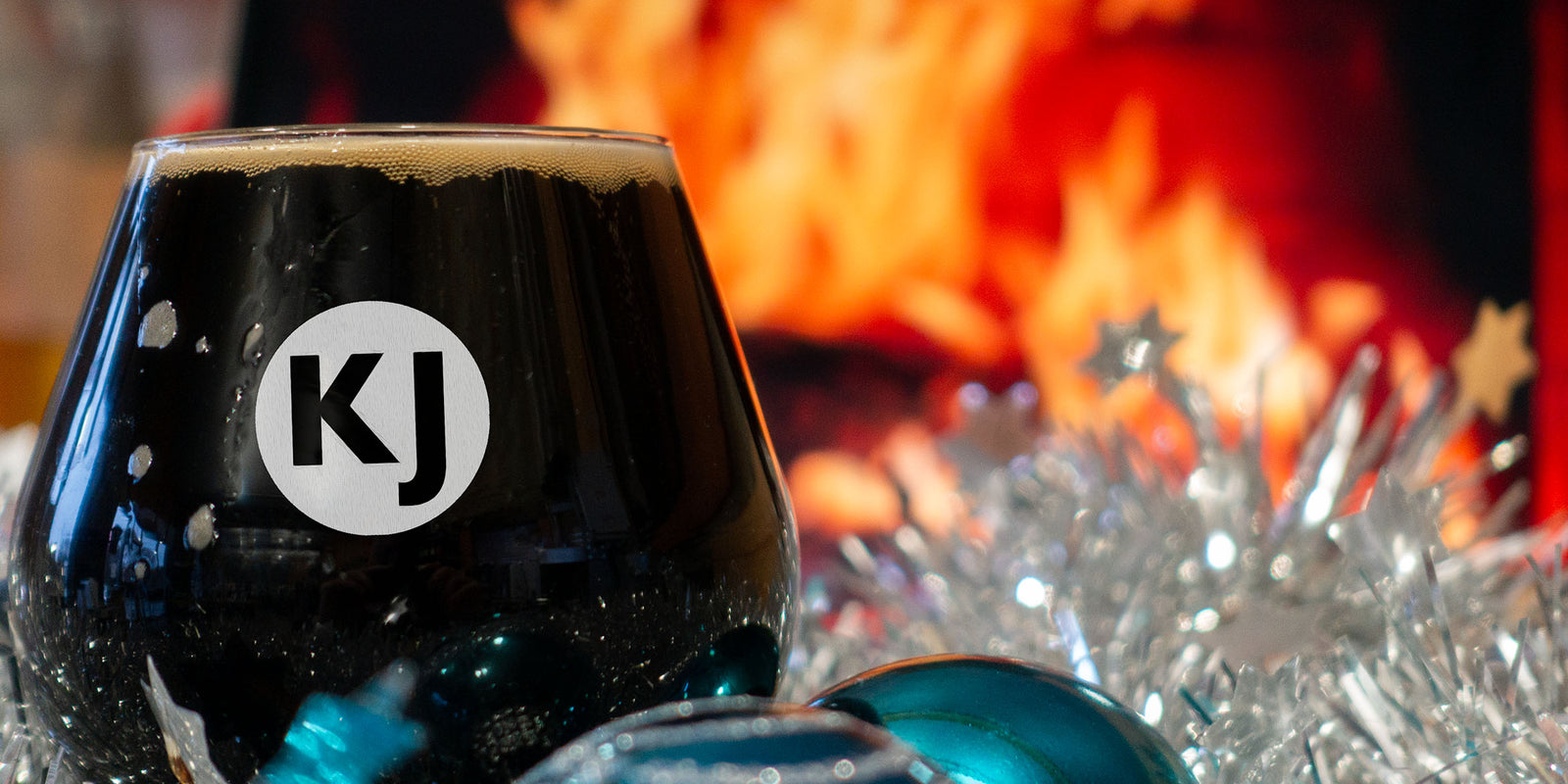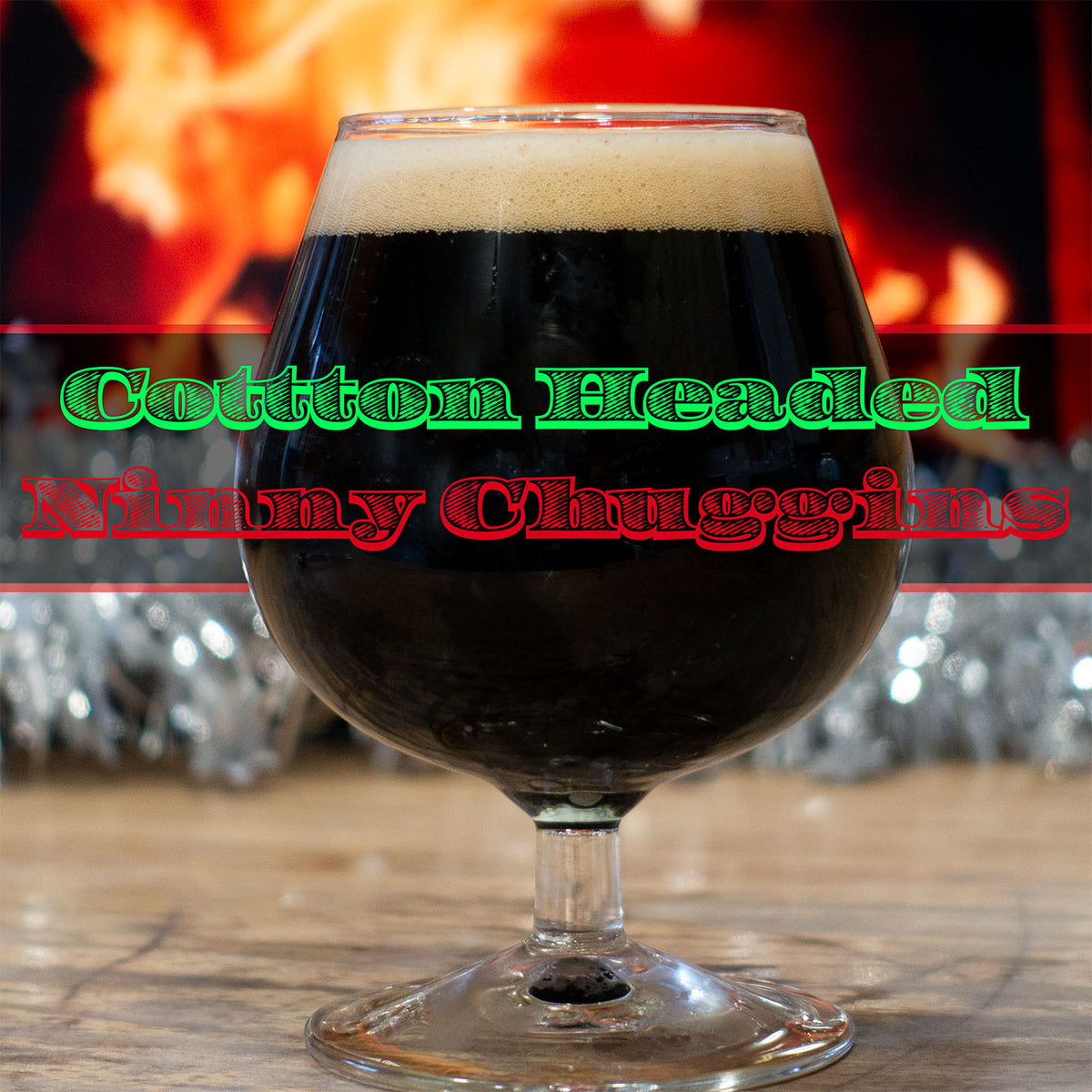Cotton Headed Ninny Chuggins - Pecan Stout Recipe
$43.99$0.00
Pecan Stout – 5.5 Gal - OG 1.061 – FG 1.014 – ABV 6.0% - IBU 37 – SRM 38
The best way to spread Christmas cheer is brewing a batch of delicious beer! Devon loves making our Christmas beer recipes, and we can definitely add this to our list of holiday faves! With one of our favourite Christmas movies (Elf) in mind, the Cotton Headed Ninny Chuggins is a delicious dark Stout whose malty, chocolatey sweetness is complemented by the smooth mouthfeel offered by flaked oats! Don’t forget to add pecan flavouring at bottling or kegging to ensure that this Christmas brew reaches its full holiday potential! It’s so good, it will have you saying, “son of a nutcracker!”
Ingredients and Instructions are listed below
Ingredients
Grains
- Canadian Pale Ale Malt x 8lbs
- Oat Malt x 1lb
- Crystal Light x 1lb
- Chocolate Malt x 1lb
- Carafa Dehusked #1 x .3lbs
- Carafoam x 0.5lbs
- Flaked Oats x 1lb
- Pecan Flavouring - 1oz
Hops
Boil Schedule (minutes)
- Nugget 0.5oz @ 60 minutes
- Nugget 0.5oz @ 30 minutes
Yeast
- S-04 Yeast
Extras (Must be purchased separately)
- Pecan Flavouring (1oz included in recipe already, extra can be purchased)
- Irish Moss - 1 tsp for last 15 minutes of boil
- DME/Dextrose - 150g at bottling for priming

Instructions
(please note, most of these pictures are from other beers - but the beauty of brewing is that the majority of steps for brewing beers are very similar, and these photos are equally instructive for any style of beer.)
Printable Instructions
Important Tips on Brewing
- Be extra cautious when it comes to cleaning! Once you have stopped boiling your wort everything that gets in contact with the beer MUST be sanitary.
- The temperature of your mash is ABSOLUTELY CRITICAL. Not being in the 150-155f range can drastically affect your beer. Make sure you correct the temperature ASAP once all the grain has been added to the mash.
- Always let your beer ferment for 10 days! Do not disturb it, do not open the lid. It is absolutely natural for the airlock to stop bubbling after a few days, it is still fermenting though.
- Oxidization: Airspace is always something to consider. When undergoing primary fermentation airspace is needed so that the beer can bubble up and ferment vigoursley without leaking out of the container. The fermentation creates a layer of CO2 that remains in the pail due to the airlock. Once primary fermentation is over, and the lid has been opened, the layer of CO2 dissipates, and oxygen replaces it. At this point airspace can ruin your beer. When racking into carboys make sure they are filled to the top, or you blast CO2 inside to prevent oxidization. Ask us for details on this!
- Before bottling, make sure you use a priming calculator (many can be found online) to verify the amount of sugar that needs to be added.
Mashing -> Converting the Grain into a Fermentable Liquid
- Bring 6 gallons of water in your brew pot to 155°F. This is our strike temperature. Turn off the heat to the pot.
- Wrap the muslin/nylon bag around the brew pot and slowly pour all the milled grains into the bag. Stir them in while adding to prevent clumps. The addition of grain should drop the temperature down to 150-155°F.
- We want to mash the grain at 154°F for 60 minutes. It is very important to hold the temperature at 154°F. If the temperature rises above 155°F it hurts the fermentation, or if it dips below 149°F it can lead to a thinner tasting beer.
- The first 15-30 minutes are essential for the success of your brew. The temperature HAS TO BE IN THE RANGE OF 150-155°F. Sometimes adding the grain to the strike water does not lower the temperature enough, in this case add a little bit of cold water to bring the temperature down. Cover the pot with your lid and let it sit.
- Most brew pots will be able to maintain 154°F without adding heat for 20 minutes, we recommend checking the temperature every 15 minutes, and if it drops add more heat to bring it up. We recommend opening the lid and using a thermometer in the liquid.
- After 60 minutes, bring the temperature of the mashing grain up to 170°F and hold for 10 minutes. This is our mash out.
- Time to remove the grain. Lift the bag full of grain out of the brew pot. Let the liquid in the bag dribble into your wort. Once that is done, put the bag inside of a brewing pail, or another empty pot. There will be about 4 gallons of wort in the brew pot, we need to get it to 6 gallons before we can begin the next stage.
- Run warm water through the grains in the bag, aim for 170°f – let it run through the grains and add to the brew pot. Add until you reach 6 gallons.
- PSA: It is natural to think that the grains need to be squeezed to get all the liquid out of them, DO NOT DO THIS. Aggressively squeezing the grains will lead to tannin extraction and a doughy taste in your beer. Lightly pressing the bag is fine, but do not try to squeeze every last drop out.
Boiling -> Sterilizing the Wort Time
- Bring 6 gallons of your wort to a rolling boil, and let it boil for 5 minutes, this is called the hot break.
- Add ½ ounce of nugget hops, then set a timer for 60 minutes, keep the wort boiling (212°f) and uncovered.
- With 30 minutes left in the timer, add the other ½ ounce of Nugget hops.
- With 15 minutes left add 1tsp of Irish Moss and if you’re using a wort chiller add that too.
- When your timer goes off, turn off the heat, and then proceed to the cooling stage.
- Now it’s time to cool the beer down to 75°f (20-25°c) as quickly as possible.
- We love using a wort chiller for this, it can get the beer down to temperature in 20-30 minutes. Otherwise, you can immerse the brew pot in an ice bath or wait it out. The longer it takes, the greater the risk of infection
Fermentation -> Turning the Wort into Beer
- After the boil is done it is time to be extra careful regarding sanitation. We recommend using a no-rinse sanitizer called Starsan. Mix ¼ tsp of it with water in a 500ml spray bottle. Before we touch any part of the beer, we spray it with Starsan.
- Transfer the cooled wort into your fermenting pail or carboy. Run it though a strainer to catch any hop or grain residue.
- It is also an important time to take a hydrometer reading. It should be around 1.061 give or take a few points.
- Your choice of fermentation vessel is important. During primary fermentation, it will bubble up quite a bit, you want to be sure there is airspace for it to work away. Otherwise, the pressure of it will push out the airlock.
- Make sure the wort has been cooled to at least 23c!!! Adding yeast at a higher temperature will likely kill it.
- Once the beer is in the fermenter, pour in the entire package of S-04 yeast. Then, put the bung and airlock in the hole (make sure there is water filled up to the line in the airlock). If using a pail, make sure the lid is sealed tight. Put the fermenter in a room that is between 18-21°C.
- Let the beer ferment for 10 -14 days, it will do the majority of the fermentation in the first few days, but letting it sit will help with clarity and settling flavours.
- After 10-14 days proceed to the bottling stage. Take a hydrometer reading. It should be somewhere between 1.010 – 1.015
- Lately, we have been of the opinion that secondary is an unnecessary step. Unless you are kegging, we recommend skipping secondary and going straight to the bottling process. Clarification can occur in the bottle rather than in a carboy, and the risk of oxidization is greatly reduced.
Bottling -> We’re getting close to Beer Time now
- Rack the now fermented beer into a bucket.
- At the same time, mix the priming sugar with 300ml of boiling water and add to the beer. Stir it in VERY gently.
- Make sure to check out a priming calculator to verify the correct amount of sugar. Too much sugar and your beer will end up foamy, or even start blowing the caps off! Too little and the beer won’t be fully carbonated.
- Add 1 ounce of the pecan flavouring to your bottling bucket/keg. If you’re feeling extra merry, you could add up to 1 more ounce but be warned this flavouring is pretty intense!
- Rack the beer into your bottles or growlers. Then, let them sit for 2-3 weeks at room temperature. Chill and enjoy!





